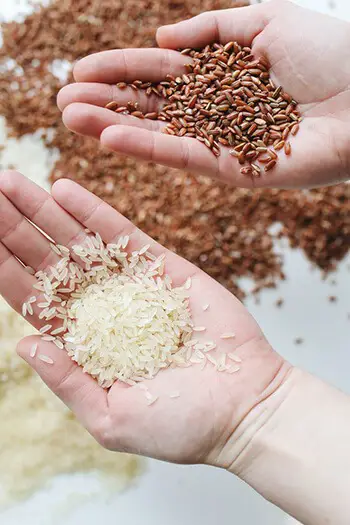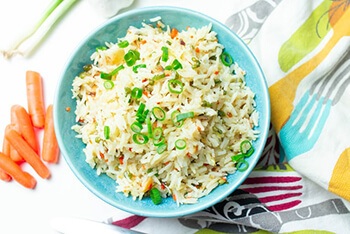Rice is a staple ingredient in an endless array of recipes, and it’s one of the most popular and well-stocked items in most people’s pantries. The enjoyable thing about this basic food is that it comes in so many varieties, and it can be used to add substance to almost every dish.
But with so many options, which is actually best? There’s lots of confusion around whether brown rice is actually better for you than white rice, and we’re here to set things straight in this video.

Brown rice
Brown rice gets its name from the colour of the grain. It is a whole grain, which means it’s made up of all three essential, unprocessed parts of the original grain: the bran, germ, and endosperm.
Many people consider brown rice to be a more healthful choice when compared to white rice. It has a lower glycaemic index, which means it’s less likely to contribute to type-2 diabetes, and it also contains more micronutrients and more fibre. It has a taste that lots of people prefer – slightly nuttier and chewier.
Eating brown rice is a great way to meet your daily whole grain needs. You might be wondering what the fuss about whole grains is, but studies have actually found that whole foods can help extend our healthy years and lower cholesterol. It’s recommended that adults eat three to five servings of whole grains every day.

Brown rice makes a great base for hearty grain bowls, and the high fibre content will help you feel fuller for longer. It also works well in dishes where a slightly nutty taste is preferred, like a pilaf with roasted veggies.
While brown rice can be substituted in almost any dish where white rice is used, you will need to keep in mind that brown rice takes a little longer to cook. It also doesn’t tend to work in creamier dishes like puddings and risottos, as it has a chewier texture.
So while brown rice may get most of the credit as being the most nutrient-rich rice, it’s not suitable for every occasion.

White rice
White rice is seen in a lot of Asian dishes. It’s less nutritious than brown rice, but it's incredibly versatile. White rice is a refined grain, which means it starts off just like brown rice, but then the bran and embryo are polished off, leaving only the starchy white endosperm. In this polishing process, the majority of the grain's B vitamins, minerals, and fibre are also removed.

When a label says that white rice is enriched, that means B vitamins and iron have been added back in — so the grain is not completely devoid of nutrients, but it’s likely to have much fewer nutrients than what occurs naturally.
Still, it’s worth appreciating white rice for the dishes it works well in, like rice pudding, fried rice, jambalaya, and more.
Providing you get your daily dose of fibre and whole grains from other food sources, like whole-wheat bread, fibre rich fruits and veggies, and oats, rye, nuts and seeds, and peas, beans, and pulses, then there’s no reason why you can’t incorporate white rice into your diet. The low fibre content of white rice might even be helpful to some people with digestive issues.
One variety of white rice, jasmine rice, is a wonderfully fragrant food and makes a perfect base for many Asian dishes with rich, savoury sauces. White Arborio rice, another variety, is the best for making unbeatable creamy risottos and rice puddings.
Is rice good for you?

So, what about rice in general? Is every variety of rice bad for you, like anyone on a keto diet will tell you? People seem to be scared of rice, and it mostly seems to come down to an ingredient it contains, called lectin.
Lectin is a plant-based protein that can lead to autoimmune disorders, diabetes, and weight gain. But you can only get sick by eating raw lectin – and who’s eating uncooked rice?
Cooking breaks down lectins, so the problem is resolved. Lectins have also been associated with health positives, like boosting the healthy bacteria living in the digestive tract, so there’s really nothing to be worried about, lectin-wise.
Conclusion
Lectins aside, which rice is actually best? You’ll certainly get more health benefits out of brown rice, but that doesn’t mean it’s the best choice for every dish.
Black and wild rice can add a new depth to your dishes, especially wild rice, which has a distinctly nutty taste that many people enjoy. So when it comes to finding the best rice for certain dishes, brown may not always be best. But if you’re eating rice on a daily basis, or lots of rice in one go, brown will provide you with the most nutrients in the long run.

